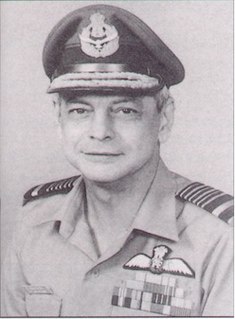
Tain Air Weapons Range is a Ministry of Defence air weapons range on the Dornoch Firth near Tain in Scotland. Royal Air Force aircrews from RAF Lossiemouth are trained in air weaponry on the range, along with NATO aircrew.

Tel Nof Israeli Air Force, also known as Air Force Base 8, is one of three principal airbases of the Israeli Air Force. It is located near Rehovot, Israel.

The Royal Indian Air Force (RIAF) was the aerial force of British India and later the Dominion of India. Along with the Indian Army, and Royal Indian Navy, it was one of the Armed Forces of British Indian Empire.
The No.3 Squadron (Cobras) of the Indian Air Force (IAF) operates as a Close Air Support (CAS) and reconnaissance unit. Currently based at Pathankot Air Force Station, No. 3 Sqn falls under the Western Air Command, and alongside the No. 26 Sqn (Warriors), No. 104HU and No.125HU (Gladiators), forms the 18 wing of the IAF.

Army Aviation Centre (AAC) Middle Wallop is a British Army airfield located near the Hampshire village of Middle Wallop, used for Army Air Corps training. The base hosts 2 (Training) Regiment AAC and 7 (Training) Regiment AAC under the umbrella of the Army Aviation Centre. 2 (Training) Regiment performs ground training; 7 (Training) Regiment trains aircrew on AAC aircraft after they complete basic training at RAF Shawbury.

No. 253 (Hyderabad) Squadron was a flying squadron of the Royal Air Force between 1918 and 1947. Originally formed in 1918, it served in WW1 flying coastal reconnaissance and anti-submarine patrols. Later in WW2 it took part in the Battle of France, the Battle of Britain, and then fought in the Mediterranean Theatre of Operations in Algeria. The squadron was disbanded on 16 May 1947, and briefly revived as a night-fighter squadron from 18 April 1955 to 2 September 1957.

Royal Air Force Chilbolton or RAF Chilbolton was a Royal Air Force station in Hampshire, England. The airfield was located in Chilbolton approximately 4 miles (6.4 km) south-southeast of Andover, about 62 miles (100 km) southwest of London
No. 6 Squadron (Dragons) is a fighter squadron and is equipped with Jaguar IM/IS and based at Jamnagar Air Force Station.
No. 4 Squadron IAF (Oorials) is a fighter squadron of the Indian Air Force (IAF) equipped with the MiG-21 Bison, based at Uttarlai Air Force Station in Uttarlai in Barmer, Rajasthan, India. Since its establishment during the South-East Asian theatre of World War II, No. 4 Squadron remains the only fighter squadron other than No. 3 Squadron IAF and No. 7 Squadron IAF to remain continuously in existence in the service of India.
No. 225 Squadron RAF is a former Royal Air Force squadron.
The Western Air Command (WAC) is the regional command of Indian Air Force headquartered in New Delhi. It is the largest and most important Air Command of the IAF, comprising sixteen Air Force Bases (AFBs), and is responsible for aerial defence of North India.
Training Command is the Indian Air Force's command responsible for flying and ground training.

Air Chief Marshal Denis Anthony La Fontaine was the 13th Chief of Air Staff of the Indian Air Force from 3 July 1985 to 31 July 1988.
Air Commodore Jagdev Chandra, (Punjabi), Royal Indian Air force and later one of the first recruits of Indian Air Force, was a war veteran, served with excellence in Burma during World War II. Was born in Peshawar, to a Punjabi family of repute, father a doctor and brother, the popular politician and Gandhian Jag Pravesh Chandra. He quit medical school to join J.R.D Tata as one of his first few students in flying. He joined the Royal Indian Air Force and was commissioned on 1 August 1940. He served as squadron leader and CO of the No.4 Squadron.

Air Marshal Ramaswamy Rajaram, DFC (1917–1969) was a senior officer in the Indian Air Force. He died in harness while serving as the Vice Chief of Air Staff (VCAS) of the Indian Air Force. He was the Air Officer Commanding-in-Chief Western Air Command during the Indo-Pakistani War of 1965.

Flying Officer Dinshaw Ferozeshaw Eduljee was the first pilot of the Indian Air Force, IAF, to receive the Air Force Cross, AFC. Eduljee is presumed to have died after the Hurricane fighter aircraft he was flying crashed in action behind Japanese lines in Burma. The circumstances and time of his death are not known.

Air Vice Marshal Harjinder Singh, PVSM, MBE was an Air Officer in the Indian Air Force. He was one of the earliest to join the newly created Indian Air Force (IAF) in 1933 in the lowest rank of 'Hawai sepoy'. In a career spanning over three decades and two wars, he rose from the lowest enlisted rank to the then second-highest rank in the Indian Air Force. Hailed as technical wizard and innovator, he is considered a legend of the IAF.










